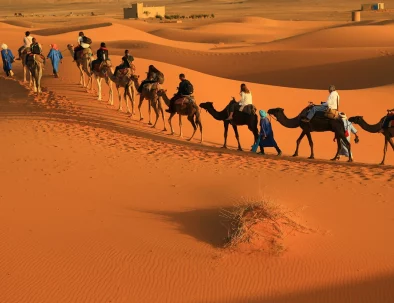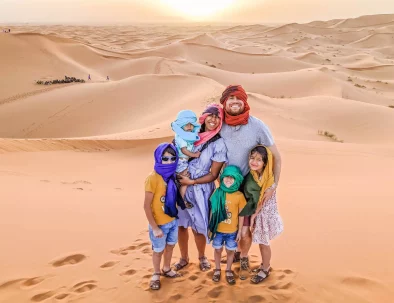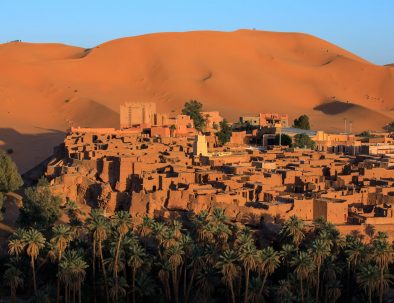Day 1: Morning in Casablanca, afternoon in Rabat
Welcome to Casablanca, The Hassan II Mosque should be your only stop in Casablanca, Morocco’s commercial hub. Its 690 feet (210 m) minaret, the tallest minaret in the world, is situated in a picturesque location on the ocean. Even though the mosque’s exterior and surroundings are impressive, it stands out because it is one of the few mosques in the nation that non-Muslims are allowed to enter. Join a mosque tour in the morning and be amazed by the exquisite craftsmanship, including the hand-carved stone and wood, the elaborate marble floor details, and the gilded ceilings.
Travel up north to Rabat, which served as the capital during the imperial era. Wander the Roman and Islamic ruins while exploring the Chellah Necropolis’ medieval fortification. Enter the old city of Rabat through the majestic door of the Kasbah des Oudaias. Visit the 20th-century Andalusian Gardens from there to take in the tranquil setting away from the crowds. Learn about the Hassan Tower, a minaret of the unfinished mosque, and the Mohamed V Mausoleum. All that is left of a 12th-century project abandoned are the mosque’s support structures, including 200 columns and the minaret.
Day 2: The Blue City of Chefchaouen
Travel to Chefchaouen in the Rif Mountains, a stunning blue city in the north. The Cascades d’Akchour (Waterfalls of Akchour), a hidden gem, are accessible via a 2- to 3-hour hike through lush vegetation and small pools before Chefchaouen. Relax in enchanting Chefchaouen in the afternoon. Chefchaouen, which has remained largely untouched since the 15th century, is known for its blue-hued buildings in its historical medina and offers a laid-back atmosphere with some of the friendliest people in the nation (old quarter). Explore the city’s winding lanes, and streets that cling to the mountain’s northern slopes.
Discover Plaza Outa el-Hammam, the central square so named because it once had several hammams (public baths) surrounding it. Before exploring the many shops selling antiques, find a restaurant or café to grab a bite. Explore the Grand Mosque, the kasbah (ancient fortress or fortification), its garden, museum, and even some of its former jail cells. As dusk falls, spend 20 to 30 minutes climbing the path to the deserted white Spanish Mosque to get one last look at Chefchaouen before the sun sets behind the mountains.
Day 3: Roman ruins at Volubilis and imperial cities of Meknes and Fes
Before leaving for Fes, get up early to take pictures of the deserted streets. Visit the Volubilis ruins, the Roman Empire’s furthest outpost in Africa, which are protected by UNESCO, as you travel. Wander the complex and discover the temples, many in-place mosaics, and merchant homes with still-working heating systems. For an introduction to your second historic imperial city, proceed to Meknes, a smaller, less populated version of Fes. The main attractions are the Ville Impériale (Imperial City) and the medina. Visit the Royal Stables, the Moulay Ismail Mausoleum, and Bab al-Mansour Gate.
Travel east until you reach Fes, the third imperial city. Fes is a city worth getting lost in because of its imposingly sizable (and occasionally perplexing) old medina. Drive up the hill to visit the Merenid Tombs, which are just north of the city, and take in the panoramic views of old Fes and the surrounding area before going into the medina. As you make your way down the hill to your riad—a traditional Moroccan home with a garden inside—you can enjoy a sumptuous meal and unwind for the evening.
Day 4: Exploring the medieval medina and the Imperial City of Fes
Of Morocco’s four Imperial Cities, Fes is the oldest and, arguably, the most fascinating and exciting to explore. It was established over a thousand years ago and had the complete medina in the Arab world. Fes el Bali and Fes el Jdid, two medina quarters, and Ville Nouvelle, a more contemporary area with French colonial influences, make up what is frequently referred to as the nation’s cultural capital. As you travel through the winding streets of the medinas, meet your guide and spend a half day learning about the history and culture of the region.
Start in Fes el Bali at the Bab Boujeloud gate and proceed into Talâa Kebira’s main street. As you pass stores and souks, take note of the architecture that has influences from Tunisia and Spain (markets). Visit the Chouara Tannery to be amazed by the numerous stone pots filled with dye, and the men working there still employ time-honored methods. After that, visit the Mellah (old Jewish quarter and cemetery) in Fes el Jdid and take in the intricate zellij tilework of the 14th-century Al Attarine Madrasa. Visit Ville Nouvelle if you have the time to see the striking transformation in the city’s architecture.
Day 5: Middle Atlas: Erfoud, Merzouga and the Sahara
Set out early in the morning and head south toward Merzouga. You will pass through the cedar forests of the Middle Atlas mountains as you make your way up and over the Col du Zad pass, which is 7,146 feet (2,178 m) above sea level. Before stopping for lunch in Midelt (the “apple city”) and savoring the nearby Moulouya River, take pleasure in sightings of the neighborhood Barbary Macaque monkeys. Enter the Ziz Valley, renowned for its hidden oases and palm tree clusters, after crossing the Tizi n’Talremt pass. Ksars, or fortified houses, were common along the road and were constructed to safeguard valuables like gold, salt, and spices.
Continue to Erfoud, a city famous for fossil mining and a date festival. You can meet some local artisans and learn more about the production process by going to a local collective in this area. Continue to Erg Chebbi, a vast sea of dunes 13.5 square miles in size (35 square km). The enormous dunes are never still; they constantly move and shift in response to the shifting wind. Once you arrive in Merzouga, mount your camel and ride through the sand to your camp, which has already been set up for you. Before heading back to camp for a sumptuous dinner and some downtime by the campfire, hike up a nearby dune to watch the sun go down.
Day 6: Desert towns, lush oases, and film worthy landscapes
Catch the sunrise on day six before renting a sandboard to put your skills to the test. Leave the dunes and travel to Khemliya to see a traditional Saharan village with Mali-born residents. Continue to the west and enter Rissani through a striking gate. A “donkey parking lot” can be found in the market town of Rissani, which is a sight to behold and hear in! Before entering the 300-meter-deep Todra Gorge, travel to the desert town of Tinerhir. You will have enough time to stroll through the gorge and unwind in the cool waters of the Todra River’s shallow bed.
The Valley of a Thousand Kasbahs can be traversed. Although many are now in poor condition, some are still occupied by local families. Even nomads herding their animals might be seen. To get to Kela’a M’gouna, go west. This area, well-known for its Festival des Roses, features extensively farmed land surrounded by fragrant rose bushes. Continue west to Ouarzazate, a well-known film industry destination that is a gateway to the Sahara Desert. Discover how the nearby desert landscapes have appeared in numerous movies by taking a studio tour.
Day 7: Aït Benhaddou Kasbah and Tizi n'Tichka Pass over the High Atlas to Marrakech
Visit the nearby city of At Benhaddou. Benhaddou, a UNESCO World Heritage site, is thought to have existed as early as the 11th century and played a significant role in the trans-Saharan trade route between Marrakech, Ouarzazate, and the southern desert. To view the surroundings, ascend the steep streets to the Granary. From there, climb the High Atlas mountain range and keep an eye out for Mount Toubkal, which is the highest peak (13,671 feet or 4,167 m). Take a break near the Tizi n’Tichka pass’s summit (7,415 feet or 2,260 m) to take in the mountain range’s scenery.
The climate and landscape will drastically change as you leave the High Atlas behind. You will soon be a part of Marrakech, the last imperial city, and all of its clamor and noise. After a long day of traveling, check into your hotel and spend the remaining time however you want. The main square, Jemaa el-Fna, comes alive in the early evening with musicians, performers, snake charmers, games, and food stalls, offering a variety of entertainment. Choose one of the many cafés surrounding the square and take in a meal and a cup of mint tea if you want to observe the spectacle from a distance.
Day 8: Marrakech: Exploring the Red City
Marrakech, also known as the “Red City” due to its red sandstone walls and structures, was once a significant trading hub for the tribes of the Atlas Mountains and is still a fascinating former imperial city. Jemaa el-Fna, Africa’s busiest square, is found in Marrakech, a city north of the foothills of the Atlas Mountains. Start your exploration of Marrakech’s historic medina at the Koutoubia Mosque and Gardens. Non-Muslims are not permitted inside the mosque, but it is still interesting to see the 253-foot (77-meter) minaret and foundations from the 12th century. Visit the adjacent garden’s fountains and pools.
Explore the intricate maze of souks hidden behind regular restaurants and shops, and indulge your senses. You can find a variety of spices, woodwork, and babouche at Souk el Attarin, Souk Chouari, and Souk Smita (traditional Moroccan slippers). To see how cloth and yarn are dyed using conventional techniques, go to the dyers’ souk or Souk des Centuries. The Ben Youssef Madrasa, a 16th-century Koranic school, is a fine example of Moroccan Islamic architecture. Pay attention to the elaborate interior decoration, which includes carved cedar ceilings, plaster sculptures, and zellij tiling.
Day 9: Departure from Marrakech
Depending on the specifics of your flight, you might want to check out the kasbah region south of Jemaa el-Fna. Visit the Saadian Tombs when you get there to see the 500-year-old craftsmanship that went into building it. As you make your way through the mullah to the 19th-century Bahia Palace, stop by the sunken gardens of the 17th-century El Badi Palace. If you have the time, you might want to visit the Dar Di Said Museum, also known as the Museum of Moroccan Arts, to see its collections of clothing, jewelry, and Hispano-Moorish decorations of exquisitely carved cedar wood.



